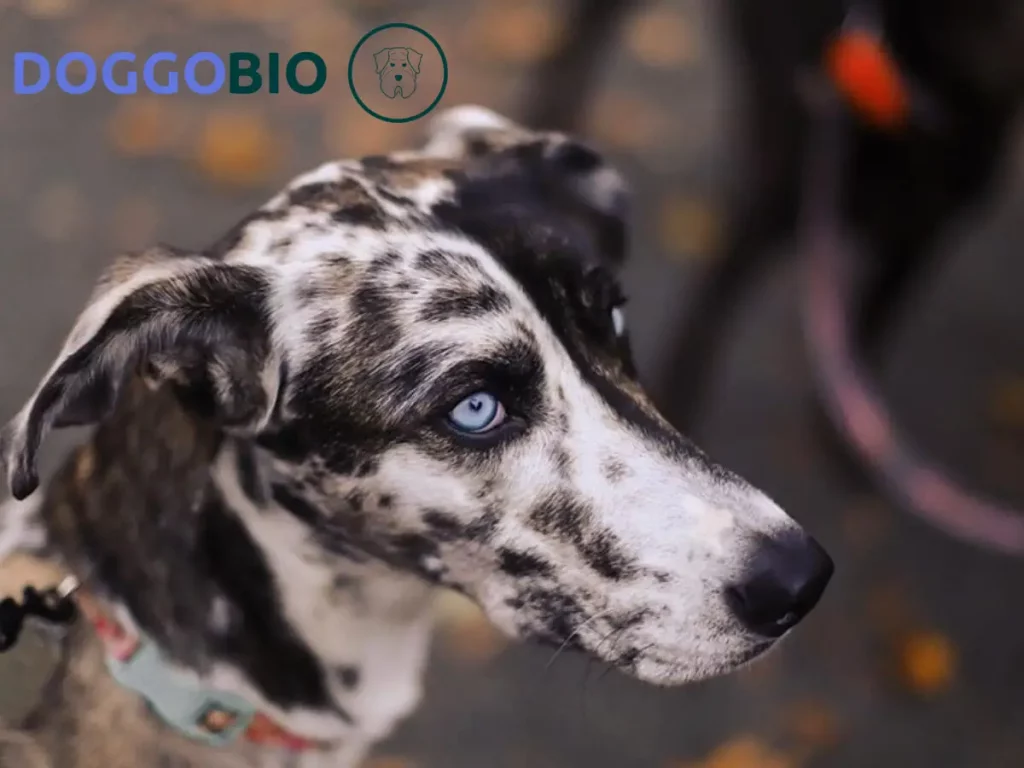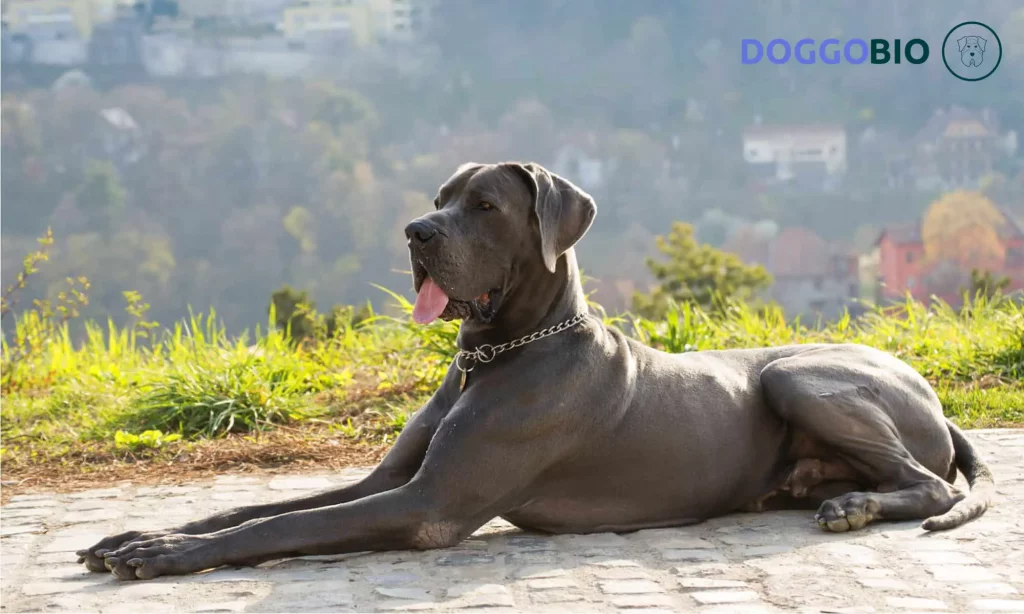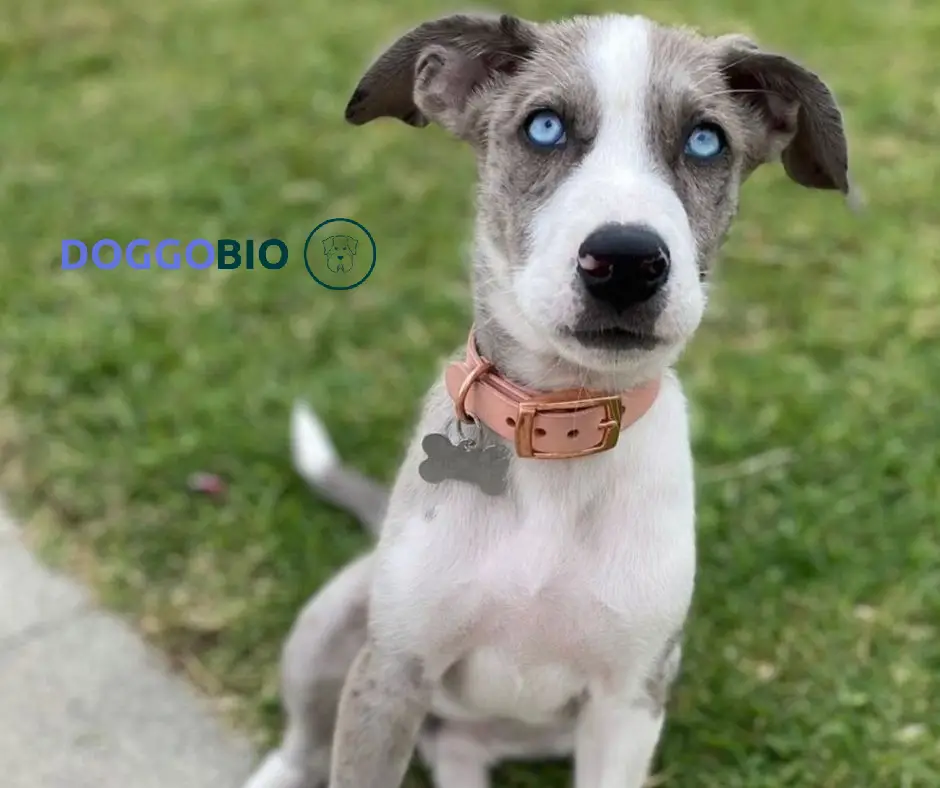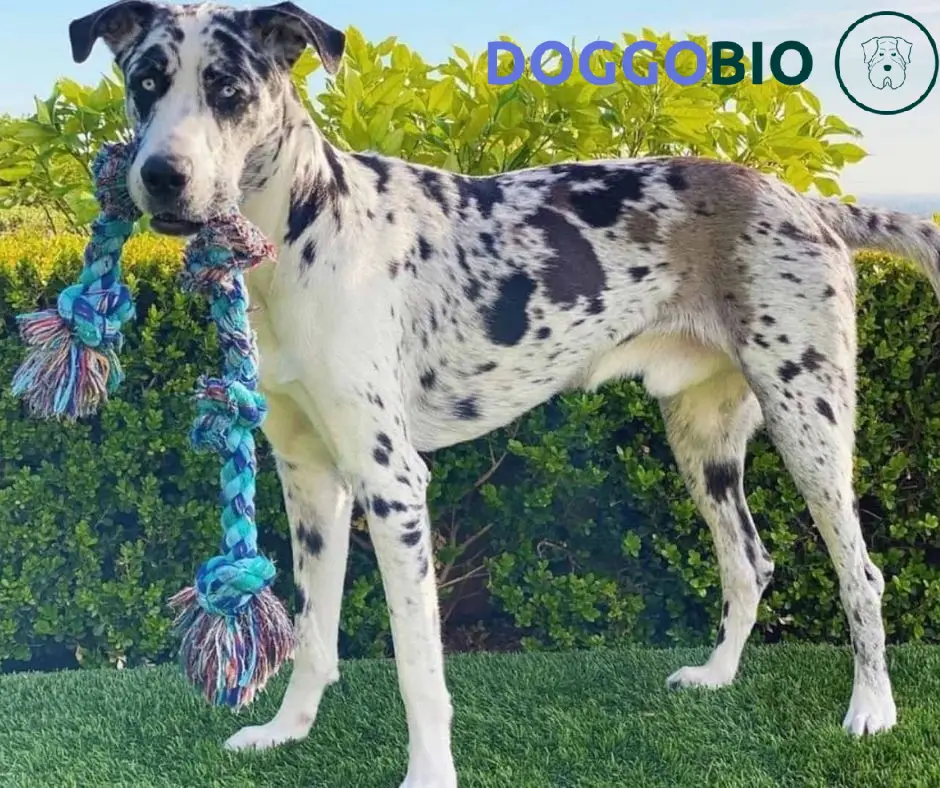The Great Dane Husky Mix, also known as the Great Danesky or the Great Daneskye, is a fascinating and unique crossbreed that results from breeding a Great Dane with a Siberian Husky. This hybrid dog typically inherits the impressive size and strength of the Great Dane, along with the beautiful and striking coat of the Husky.
The Great Dane Husky mix is a friendly, intelligent, and affectionate dog that makes a great companion for families, individuals, or active households. With their playful nature and high energy levels, these dogs love to run, play, and explore, making them an excellent choice for those who enjoy an active lifestyle.
If you’re looking for a loyal, loving, and unique dog that’s sure to turn heads, the Great Dane Husky mix might be the perfect addition to your family.
A Brief overview of Great Dane Husky Mix
| Great Dane Husky Mix | |
| Other Names | Danesky, Great Danesky, Husky Dane, Dane Husky Mix |
| Purity | Hybrid dog |
| Purpose | Companion dog |
| AKC Recognition | No |
| Size | Large |
| Weight | Approximately 110 pounds |
| Height | 21 to 35 inches |
| Coat Colors | Blue, Black, Fawn, Harlequin, Merle, Brindle, Mantle |
| Child Friendliness | High |
| Canine Friendliness | Moderate |
| Training Difficulty | High |
| Grooming Upkeep | High |
| Exercise Needs | Moderate |
What is a Great Dane Husky Mix?

The Husky Great Dane Mix, or the Great Danesky, is a captivating designer dog breed. It results from crossbreeding the Siberian Husky and the Great Dane, two purebred dog breeds with distinct origins. The Husky, native to Siberia, and the Great Dane, originally from Germany, have unique characteristics that make the Great Danesky an exciting combination.
Although the origins of this hybrid breed are not entirely clear, its popularity has surged in recent years. With the increasing demand for new and unique dog breeds, the Husky Great Dane Mix is becoming a sought-after option. It is an excellent choice for those who want a dog that combines the best traits of both parent breeds.
Parent Breeds of Great Dane Husky Mix
Origins and History of The Great Dane

The Great Dane, also known as the German Mastiff, is a majestic and historically significant working dog breed from Germany. Standing at 28 to 32 inches tall and weighing between 110 to 175 pounds, they are noted for their impressive stature. Originally bred for boar hunting in the 19th century, Great Danes have transitioned into devoted family pets, forming deep bonds with their owners.
Despite their size, these dogs are affectionate and friendly, though they may be somewhat clumsy around children. They are calm yet protective, serving as vigilant guardians of their homes. Great Danes possess a mix of energy and a love for relaxation, often seeking affection without realizing their own immense size.
Socially adaptable, they get along well with other dogs and strangers, especially with proper socialization. Their coat comes in seventeen different shades, including standard colors like black, white, blue, merle, and brindle. Their short coats are low-maintenance, requiring only weekly brushing despite their large size. These attributes, combined with their history as working dogs, make Great Danes a remarkable and versatile breed.
Origins and History of Husky

The Husky, a medium-sized breed standing 20 to 23.5 inches tall and weighing 35 to 60 pounds, is renowned for its vibrant energy and spirited nature. Originating from Siberia for sledding, these dogs are packed with vitality and enjoy active play.
Well-suited for families, the Husky is friendly with strangers, children, and other dogs, though training and socialization are crucial for managing their lively disposition. Their thick double coat, suitable for cold climates, also adapts to warmer environments, but requires significant grooming, especially during biannual shedding periods.
Available in nine colors, Huskies have a strong prey drive, often chasing small animals. Despite this, their appealing qualities make them a popular choice for crossbreeding with other breeds.
What Does a Great Dane Husky Mix Look Like?
The Danesky, a blend of the Great Dane and Husky, showcases a distinctive and variable appearance. As a large breed, it may inherit the Great Dane’s long muzzle and floppy ears, or the Husky’s erect ears and almond-shaped eyes.
The coat of a Danesky can range in color and length, potentially featuring the Husky’s iconic mask. While not officially recognized by the American Kennel Club, this mix’s striking and unpredictable looks make it a standout breed.
Size, height, and weight
The Danesky, a Great Dane-Husky mix, is notably large.
- Typically standing up to 35 inches tall, they’re among the taller breeds. While some might be slightly shorter, they’re still imposing compared to other dogs.
- In terms of weight, Daneskys range between 90 and 170 pounds, showcasing their muscular build.
| Height | Weight | |
| 6 months | 18 to 25 inches | 30 to 80 pounds |
| 9 months | 19 to 23 inches | 50 to 90 pounds |
| 1 year | 21 to 35 inches | 60 to 110 pounds |
Coat colors and types
Coat colors in dogs range widely, with common options including fawn, black, black and white, harlequin, brindle, and merle. However, the vast array of genetic combinations means there are potentially hundreds more colors yet to be seen.
Temperament and Personality

The Danesky’s temperament blends traits from both Great Danes and Huskies. While it may inherit the Great Dane’s guard dog instincts, these could be tempered by the Husky’s sociable nature. Key to shaping their personality is early and consistent training, with positive reinforcement being particularly effective.
Socialization from a young age is crucial to moderate their prey drive and ensure comfort around other animals and people. As both parent breeds are social, the Danesky dislikes being left alone for long periods, potentially developing separation anxiety if left for more than four hours.
Remember, dogs perceive time differently than humans, and prolonged solitude can lead to anxiety and destructive behavior. While some breeds manage up to eight hours alone, most are better with a maximum of four hours of solitude. Therefore, if your lifestyle involves long absences, a Danesky might not be the ideal pet.
Generally, the Great Danesky is a gentle, affectionate breed, excellent for families, though supervision is advised around small children due to their size.
Is Great Dane Husky Mix a good fit for families?
The Great Dane Husky mix can be an excellent fit for families, particularly those with older children, given its large size. This breed is known for its friendly temperament and gets along well with most people, making it a suitable companion for family environments. Early socialization is key to nurturing its amicable nature.
For socialization, regular leisurely walks are a great way to introduce your dog to various social situations. Additionally, enrolling in puppy playtime classes can provide a structured approach to socialization, helping your Great Dane Husky mix become well-adjusted and comfortable around different people and environments.
Is Great Dane Husky Mix aggressive?
No,The Great Dane Husky Mix is generally not predisposed to aggression, given that both the Great Dane and Siberian Husky are recognized for their friendly and obedient nature.
However, like any dog, they can become aggressive in specific situations, especially if they feel threatened or haven’t been properly socialized or trained. While they aren’t inherently aggressive, it’s crucial to train and socialize them early to maintain their gentle temperament.
Training

The perplexing nature of training a Great Dane Husky Mix can challenge even the most seasoned dog owner. These two breeds are known for being independent and stubborn, making training daunting. But fear not. With ample patience and time, your Great Dane Husky Mix can be prepared to be a well-behaved companion. Here are some tips to help you get started:
1.The early training
Training your dog while they are still puppies can be beneficial as they learn faster at this stage. Start with house and crate training and gradually move on to more complicated tasks. This will make it easier for your dog to learn new tricks as they age.
2.Use positive encouragement
Punishing your dog when disobeying can cause anxiety and discomfort, leading to health issues. Instead, employ positive reinforcement techniques. Praise your dog when they complete a task and reward them with treats or affection.
3.Socialize
Early socialization is essential for your mixed breed to be comfortable around children and pets. Expose them to different people, places, and animals, and help them understand acceptable behavior.
4.Consistency
Consistency is crucial when training your dog. Try to teach simultaneously and in the same place every day. This will help your dog remember and retain new information more effectively.
Following these tips, you can train your Great Dane Husky Mix to be a happy and obedient companion. You can overcome their stubborn tendencies and help them become well-behaved family members with patience and persistence.
Exercise Requirements
The Great Dane Husky mix needs ample exercise for both physical and mental well-being. Regular daily walks are crucial, but due to its size, early and ongoing socialization is important, especially when interacting with other dogs.
Given the Siberian Husky lineage, crate training might not be ideal for this mix as it can lead to undesirable behaviors like barking or howling. These dogs thrive on human interaction, inherited from both parent breeds’ sociable natures.
It’s important to note that this breed is prone to separation anxiety if left alone for long periods. Therefore, if you have a busy work schedule or an unpredictable lifestyle, this breed might not be the best fit for you.
Living Conditions
The Great Dane Husky Mix’s size is no joke; you’ll need a roomy house to accommodate them. But it’s not just about space. Your dog also needs ample room to move and stretch those big ol’ legs. So, ensure you have a secure yard or access to nearby parks for your pup to exercise.
Grooming and Cleaning
Grooming a Great Dane Husky mix varies depending on which parent’s coat it inherits. If it has the Great Dane’s short coat, grooming is minimal, with weekly brushing usually sufficient, although they may shed more in spring and fall, requiring more frequent brushing during these times.
If the mix takes after the Husky’s thick fur, expect year-round shedding and a need for more regular grooming. Bathing should be done only when necessary, using appropriate dog-friendly products to avoid skin or fur issues.
Don’t forget other grooming essentials like regular teeth brushing for oral health, nail clipping for outdoor activities, and ear cleaning to prevent wax build-up. These practices are important for the overall well-being of your Great Dane Husky mix.
| Grooming need | Frequency |
| Coat brushing | Once a week. |
| Bathing | Depending on the activity level, once a week to once every 2 months. |
| Nail trimming | As needed. |
| Ear cleaning | Once a week. |
Are Great Dane Husky Mixes Hypoallergenic?
No, Great Dane Husky Mixes are not hypoallergenic. These hybrids often inherit moderate to heavy shedding tendencies from both parent breeds. Consequently, people with allergies to pet dander and hair should carefully consider before choosing a Great Dane Husky Mix as a pet.
Food and Diet
Understanding the mother’s breed can guide the dietary needs of a Great Dane Husky mix. If it takes after the Great Dane, opt for food meant for giant breeds; if it’s more Husky-like, choose large breed formulas. Age also plays a role, with puppies requiring different nutrition than adults.
Active lifestyles of both parent breeds generally prevent obesity, but regular body condition checks are recommended. Even in thicker-coated dogs, ribs should be palpable. Keep treats to 10% of their total calorie intake for optimal health and nutrition.
Common Health Issues

It’s no secret that all dogs have specific genetic health problems. However, with a mix like the Great Dane Husky Mix, predicting which diseases may come from the parents’ bloodline is tough.
As a responsible pet owner, you must know the following diseases that affect both breeds which your pup might be prone to:
1.Lymphoma Cancer
Lymphoma cancer is a significant concern in dogs, commonly affecting their lymphatic system. This type of cancer leads to symptoms such as swollen lymph nodes and concerning weight loss, causing distress in affected pets and their owners.
2.Degenerative Myelopathy
Degenerative Myelopathy is a hereditary disease in dogs that affects the spinal cord and nerves, leading to distressing symptoms such as incontinence. It’s a challenging condition to manage and significantly impacts the health and well-being of affected dogs.
3.Cardiomyopathy
Cardiomyopathy, a serious condition affecting the heart chambers of dogs, has significant physical and emotional impacts on both the pets and their owners. Early recognition of its signs and symptoms is crucial for providing effective care and support.
4.Wobbler Syndrome
Wobbler Syndrome is a complex condition affecting the spine and neck of dogs, leading to symptoms like stiffness and potentially paralysis. Its intricate nature often challenges veterinarians, underlining the importance of prompt and thorough diagnosis and treatment for the well-being of affected dogs.
5.Laryngeal Paralysis
Laryngeal Paralysis, a condition affecting the tracheal opening, complicates breathing in dogs. Its complex nature, influenced by both genetics and environmental factors, presents a challenge for diagnosis and treatment. Early detection and thorough treatment are crucial for the effective care of dogs with this condition.
6.Hip Dysplasia
Hip dysplasia, a common bone disorder in dogs, occurs when the hip’s ball and socket joint fails to develop correctly, leading to joint wear and reduced function. While not exclusive to the Great Dane Husky mix, it’s prevalent in many breeds. Prospective owners should research the health histories of both parent breeds to assess the risk of this condition.
7.Osteosarcoma
Osteosarcoma is an aggressive bone cancer affecting large and giant dog breeds, often causing severe pain. It primarily attacks the leg bones but can also spread to the spine or skull. This disease can affect dogs of any age, making it a significant concern for dog owners globally.
8.Bloat
Bloat, or Gastric Dilatation and Volvulus (GDV), is a life-threatening condition particularly dangerous for larger dog breeds. It happens when the stomach fills with food, fluid, and gas, causing extreme expansion. This expansion puts pressure on surrounding organs, leading to critical issues like stomach tearing, breathing difficulties, and reduced heart blood flow. Immediate surgical intervention is essential to address this urgent medical emergency.
9.Eyes problem
Progressive Retinal Atrophy (PRA) is a serious eye condition in dogs, characterized by a deteriorating retina that impairs vision. As PRA progresses, it leads to a gradual loss of sight, eventually resulting in complete and irreversible blindness.
How Long Does a Great Dane Husky Mix Live?
The average lifespan of the Great Dane Husky Mix ranges from 8 to 13 years, underscoring the importance of providing our furry friends with the best possible care and support throughout their lives.
Whether through a nutritious diet, regular exercise, or timely medical attention, there are a host of strategies that can help extend the lifespan of our beloved pets and ensure that they enjoy a long and healthy existence by our sides.
How Much is a Great Dane Husky Mix?
In the world of canine commerce, few breeds command as much attention and admiration as the Great Dane Husky Mix. Yet, with this coveted status comes a hefty price tag, and prospective pet owners must be prepared to shell out anywhere from $800 to $1,000 for the privilege of owning one of these magnificent creatures.
Is Great Dane Husky Mix the Right Dog For Me?
Before adopting a Great Dane Husky Mix, consider if this breed suits you.
It’s best for experienced dog owners who can handle a large, independent, and occasionally mischievous dog. The maintenance of such a large breed can be more demanding and costly, making it challenging for first-time dog owners.
Thoughtful preparation is crucial before welcoming a Great Dane Husky Mix into your home.
List of dogs that are similar to Great Dane Husky Mix
- Husky-Dalmatian Mix
- Husky-French Bulldog Mix
- Husky-Doberman Mix
- Husky-Cane Corso Mix
- Husky-Rottweiler Mix
- Great Dane-Golden Retriever Mix
- Merle Great Dane
- Great Dane-Chihuahua Mix
- Great Dane-Doberman Mix
Frequently Asked Questions
1.Do Great Dane Husky Mixes Get Along With Other Pets?
Yes, but with caution. Great Dane Husky Mixes can get along with other pets, particularly since Siberian Huskies are usually friendly with other dogs. However, due to a moderate prey drive inherited from both parent breeds, they might chase smaller animals, especially if they have the Great Dane’s larger size. It’s important to be careful when introducing a Danesky to a household with cats or smaller pets.
2.What is another name for Great Dane Husky Mix?
This impressive canine can be called a Danesky, Great Danesky, Husky Dane, or Dane Husky Mix, depending on your preference or the occasion.
Conclusion
In conclusion, the Great Dane Husky mix is a fascinating and lovable hybrid breed that offers a perfect blend of the Great Dane’s strength and the Husky’s striking appearance. This friendly and intelligent dog makes an excellent companion for active households, families, and individuals who enjoy spending time outdoors.
With proper training, socialization, and care, the Great Dane Husky mix can become a loyal and affectionate family member that brings joy and happiness to your life. Whether you’re looking for a running partner, a snuggle buddy, or simply a unique and fascinating pet, the Great Dane Husky mix is a breed worth considering.

Pingback: Dalmatian Husky Mix: Interesting Facts You Need to Know 2023
Pingback: Doberman Husky Mix: Fascinating Facts You Need to Know 2023
Pingback: Rottweiler Husky Mix: Discover the Secrets to Nurturing 2023
Pingback: French Bulldog Husky Mix: Dive into the Interesting World 2023
Pingback: Doberman Husky Mix: Fascinating Facts You Need to Know 2024
Pingback: Merle Great Dane Majesty: Unraveling Coat Patterns 2024
Pingback: Great Dane Golden Retriever Mix: The Majestic Breed 2024
Pingback: Cane Corso Husky Mix: Interesting Fact You Need to Know 2024